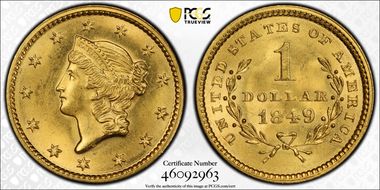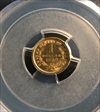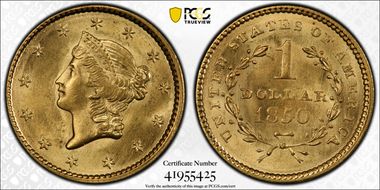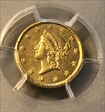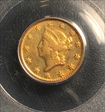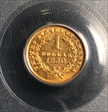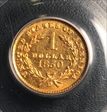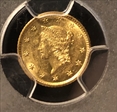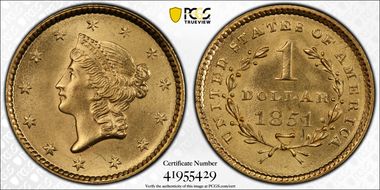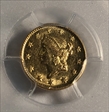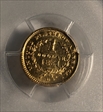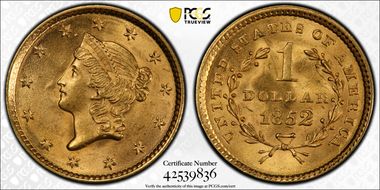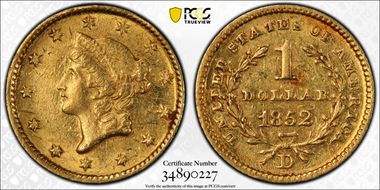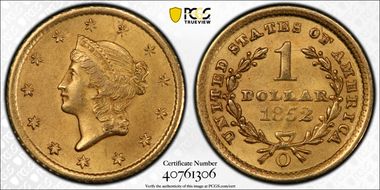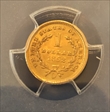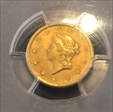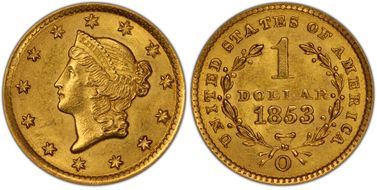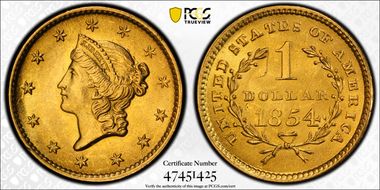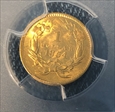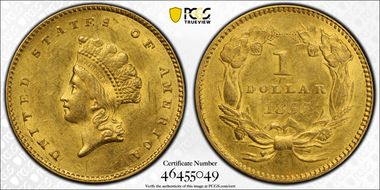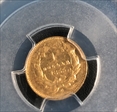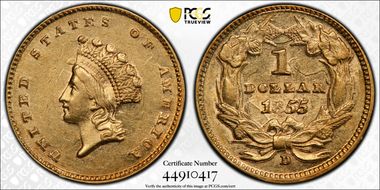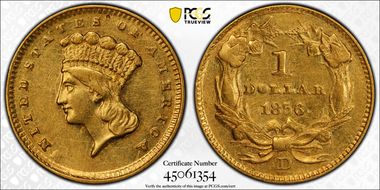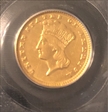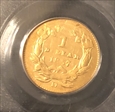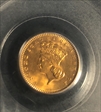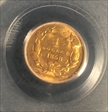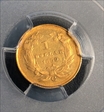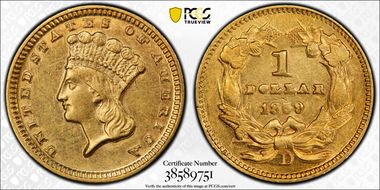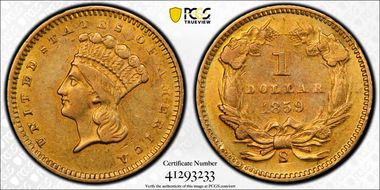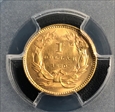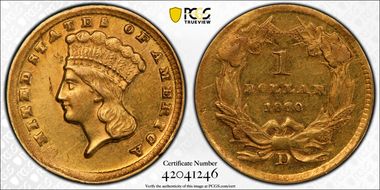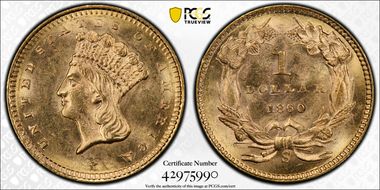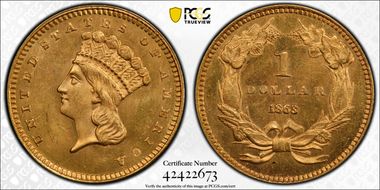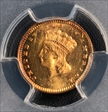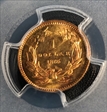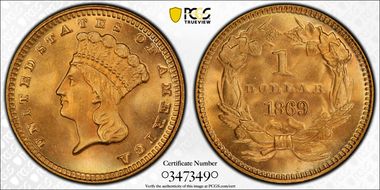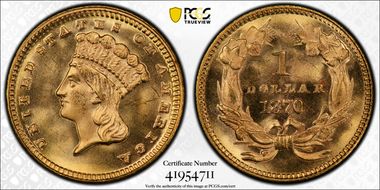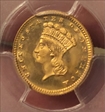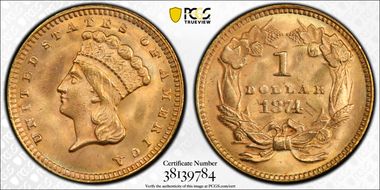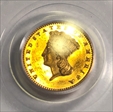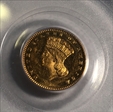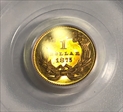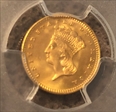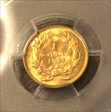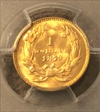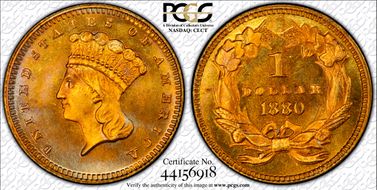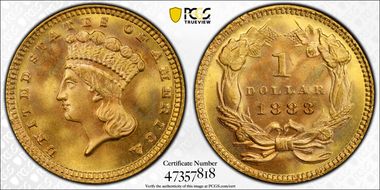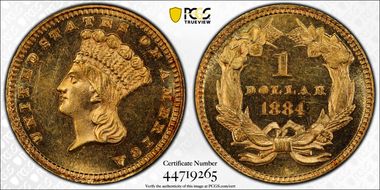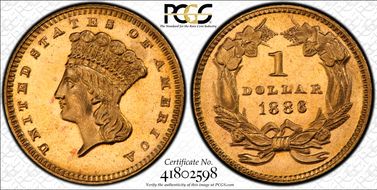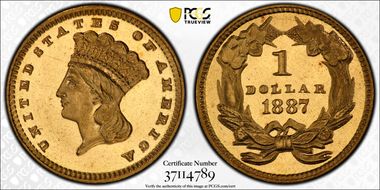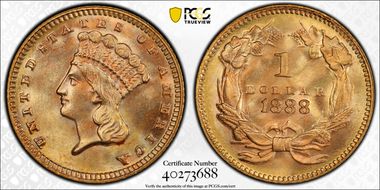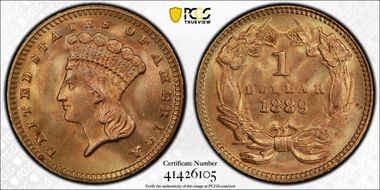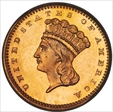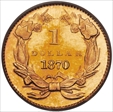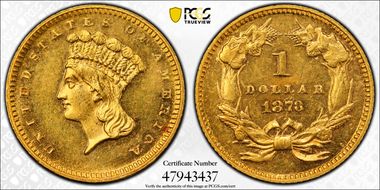TJK Family Collection 的钱币相册
1849 G$1 Open Wreath, D-4, Close Stars, MS66 PCGS. Ex: Harry W. Bass, Jr. Collection. Thin date numerals, Breen-6004. The E in UNITED is repunched. The 1849 California Gold Rush resulted in two new denominations, the gold dollar and the double eagle. The gold dollar design enjoyed multiple revisions in its first year, with D-4 as the final subtype. This highly lustrous Premium Gem displays smooth sun-gold surfaces, and exhibits outstanding eye appeal. The strike shows minor blending on the 8 in the date and the second L in DOLLAR. Ex: Purchased from Don Quiggins (11/1972). From The Harry W. Bass, Jr. Core Collection, Part III.
EX. The Gold Coast Collection 1850-C G$1 MS61 PCGS. Variety 1. The 1850-C boasts a low mintage of only 6,966 pieces. In Gold Coins of the Charlotte Mint, third edition, Doug Winter writes, "From the standpoint of overall rarity, it is tied with the 1859-C as the second rarest gold dollar from this mint." An 150 to 250 pieces are believed known in all grades. This Mint State coin displays bright yellow-gold surfaces and sharply rendered devices, with minor abrasions that define the grade. Population: 14 in 61, 9 finer (2/22). From The Gold Coast Collection.
EX. The Gold Coast Collection 1850-C G$1 MS61 PCGS. Variety 1. The 1850-C boasts a low mintage of only 6,966 pieces. In Gold Coins of the Charlotte Mint, third edition, Doug Winter writes, "From the standpoint of overall rarity, it is tied with the 1859-C as the second rarest gold dollar from this mint." An 150 to 250 pieces are believed known in all grades. This Mint State coin displays bright yellow-gold surfaces and sharply rendered devices, with minor abrasions that define the grade. Population: 14 in 61, 9 finer (2/22). From The Gold Coast Collection.
EX. The Gold Coast Collection 1850-C G$1 MS61 PCGS. Variety 1. The 1850-C boasts a low mintage of only 6,966 pieces. In Gold Coins of the Charlotte Mint, third edition, Doug Winter writes, "From the standpoint of overall rarity, it is tied with the 1859-C as the second rarest gold dollar from this mint." An 150 to 250 pieces are believed known in all grades. This Mint State coin displays bright yellow-gold surfaces and sharply rendered devices, with minor abrasions that define the grade. Population: 14 in 61, 9 finer (2/22). From The Gold Coast Collection.
EX. The Gold Coast Collection 1850-C G$1 MS61 PCGS. Variety 1. The 1850-C boasts a low mintage of only 6,966 pieces. In Gold Coins of the Charlotte Mint, third edition, Doug Winter writes, "From the standpoint of overall rarity, it is tied with the 1859-C as the second rarest gold dollar from this mint." An 150 to 250 pieces are believed known in all grades. This Mint State coin displays bright yellow-gold surfaces and sharply rendered devices, with minor abrasions that define the grade. Population: 14 in 61, 9 finer (2/22). From The Gold Coast Collection.
1850-O G$1 MS62 PCGS. Variety 1. Doug Winter writes: "The 1850-O is easily the rarest of the five Type One gold dollar produced at the New Orleans Mint. It is the only one of these issues which is hard to find in strictly Uncirculated grades and it is rare above properly graded MS62." This impressive example displays lustrous yellow-gold surfaces and a pinpoint-sharp strike throughout. Small grazes and marks are superficial. Population: 12 in 62, 11 finer (6/21).(Registry values: N2998)
1850-O G$1 MS62 PCGS. Variety 1. Doug Winter writes: "The 1850-O is easily the rarest of the five Type One gold dollar produced at the New Orleans Mint. It is the only one of these issues which is hard to find in strictly Uncirculated grades and it is rare above properly graded MS62." This impressive example displays lustrous yellow-gold surfaces and a pinpoint-sharp strike throughout. Small grazes and marks are superficial. Population: 12 in 62, 11 finer (6/21).(Registry values: N2998)
1850-O G$1 MS62 PCGS. Variety 1. Doug Winter writes: "The 1850-O is easily the rarest of the five Type One gold dollar produced at the New Orleans Mint. It is the only one of these issues which is hard to find in strictly Uncirculated grades and it is rare above properly graded MS62." This impressive example displays lustrous yellow-gold surfaces and a pinpoint-sharp strike throughout. Small grazes and marks are superficial. Population: 12 in 62, 11 finer (6/21).(Registry values: N2998)
1850-O G$1 MS62 PCGS. Variety 1. Doug Winter writes: "The 1850-O is easily the rarest of the five Type One gold dollar produced at the New Orleans Mint. It is the only one of these issues which is hard to find in strictly Uncirculated grades and it is rare above properly graded MS62." This impressive example displays lustrous yellow-gold surfaces and a pinpoint-sharp strike throughout. Small grazes and marks are superficial. Population: 12 in 62, 11 finer (6/21).(Registry values: N2998)
Ex. Gold Coast Collection 1851-D Gold Dollar, MS62 Conditionally Rare Dahlonega Type Coin 1851-D G$1 MS62 PCGS. Variety 3-E. The leaf is positioned centrally under the second 1 in the date. From a mintage of just 9,882 coins, the 1851-D is the secondmost available date in the series among Dahlonega issues after the 1849-D. Winter (2013) estimates that only 15 to 20 Mint State representatives are extant, primarily in MS60 and MS61. This example features light yellow-gold surfaces. The strike is generally sharp with typical softness on the stars below Liberty's portrait, on LLA in DOLLAR, and on 85 in the date. Good for type. Population: 15 in 62, 10 finer (2/22). Ex: PNG Dallas Invitational (Heritage, 2-3/2015), lot 3198.
Ex. Gold Coast Collection 1851-D Gold Dollar, MS62 Conditionally Rare Dahlonega Type Coin 1851-D G$1 MS62 PCGS. Variety 3-E. The leaf is positioned centrally under the second 1 in the date. From a mintage of just 9,882 coins, the 1851-D is the secondmost available date in the series among Dahlonega issues after the 1849-D. Winter (2013) estimates that only 15 to 20 Mint State representatives are extant, primarily in MS60 and MS61. This example features light yellow-gold surfaces. The strike is generally sharp with typical softness on the stars below Liberty's portrait, on LLA in DOLLAR, and on 85 in the date. Good for type. Population: 15 in 62, 10 finer (2/22). Ex: PNG Dallas Invitational (Heritage, 2-3/2015), lot 3198.
Ex. Gold Coast Collection 1851-D Gold Dollar, MS62 Conditionally Rare Dahlonega Type Coin 1851-D G$1 MS62 PCGS. Variety 3-E. The leaf is positioned centrally under the second 1 in the date. From a mintage of just 9,882 coins, the 1851-D is the secondmost available date in the series among Dahlonega issues after the 1849-D. Winter (2013) estimates that only 15 to 20 Mint State representatives are extant, primarily in MS60 and MS61. This example features light yellow-gold surfaces. The strike is generally sharp with typical softness on the stars below Liberty's portrait, on LLA in DOLLAR, and on 85 in the date. Good for type. Population: 15 in 62, 10 finer (2/22). Ex: PNG Dallas Invitational (Heritage, 2-3/2015), lot 3198.
Ex. Gold Coast Collection 1851-D Gold Dollar, MS62 Conditionally Rare Dahlonega Type Coin 1851-D G$1 MS62 PCGS. Variety 3-E. The leaf is positioned centrally under the second 1 in the date. From a mintage of just 9,882 coins, the 1851-D is the secondmost available date in the series among Dahlonega issues after the 1849-D. Winter (2013) estimates that only 15 to 20 Mint State representatives are extant, primarily in MS60 and MS61. This example features light yellow-gold surfaces. The strike is generally sharp with typical softness on the stars below Liberty's portrait, on LLA in DOLLAR, and on 85 in the date. Good for type. Population: 15 in 62, 10 finer (2/22). Ex: PNG Dallas Invitational (Heritage, 2-3/2015), lot 3198.
CAC A wonderful near-GEM example of this popular New Orleans mint gold dollar. A strong mint luster radiates boldly with an intense brilliance. Well struck and nicely preserved, the surfaces are clean and free of any kind of distracting marks of any kind. The outstanding eye appeal is further enhanced by a warm orange-gold coloration. Conditionally challenging any finer! Ex Maurice Storck Collection, Heritage, October 2020, lot 18309.
1852-C Gold Dollar. Winter-2. MS-64+ (PCGS). CAC. This is one of the most exciting Charlotte Mint gold coins of any denomination or date that we have offered in recent sales. It is a thoroughly PQ example with quality and eye appeal seldom seen in Southern gold coins from this mint. The luster is full, bright and frosty, and the fields are modestly semi-reflective. The coin exhibits vivid medium gold color throughout, as well as a bold to sharp strike. Most features are fully rendered, in fact, and softness in the center of the reverse affecting the letters LA in DOLLAR is the result of a shallow, Mint-made depression in the planchet that is also present on the 2008 Winter plate coin, among others that we have handled over the years. (This feature is likely the result of foreign matter adhering to the reverse die.) In the absence of significant marks, this is a smooth-looking coin in hand with exceptional eye appeal. From a mintage for the date of just 9,434 pieces, down more than 31,833 pieces from the Charlotte Mint gold dollar output of the preceding year. This elusive issue is found in VF or EF more often than not, and even pleasing Choice AU coins are definitely among the minority of the 250 to 350 examples thought to exist. Mint State survivors of all stripes are rare, while with the quality, originality and eye appeal offered here they are exceedingly so. This is the last Charlotte Mint gold dollar until the Type II 1855-C, and after that the Carolina Mint issued gold dollars in just two years, 1857 and 1859. A fantastic condition rarity that would do equal justice to a gold dollar collection or an advanced Southern gold cabinet. Winter-2 is the more readily obtainable die pairing of the 1852-C gold dollar, and it is readily identifiable by repunching to the digits 18 in the date. The offered coin reveals faint clash marks in the fields when studied under magnification. PCGS Population: 1; 1 finer (MS-65 finest). CAC Population: 4; 1. The former total includes coins certified both MS-64 and MS-64+.
Was purchased as NGC certified MS61, sent into PCGS March 2023 and crossed to PCGS AU58
Was purchased as NGC certified MS61, sent into PCGS March 2023 and crossed to PCGS AU58
An uncommonly attractive survivor of this challenging Type II gold dollar. Both sides exhibit bright honey-gold color with intermingled pale apricot highlights. Abundant frosty to semi-reflective luster remains to surfaces that reveal only a trace of rub, and no sizeable or otherwise singularly notable marks. The digit 8 is softly defined, and the hair curls above Liberty's brow are blunt and devoid of finer detail. Otherwise, however, we note bold to sharp detail throughout the design. The surfaces show clash marks in the fields around the central design elements, typical of the type. Preserved with uncommon care for an issue that suffered a high rate of attrition through circulation and melting, this is a superior 1855-D in all categories that is sure to please discerning bidders. The 1855-D is one of the rarest gold dollars struck at the Dahlonega Mint, if not the entire series, and it is also eagerly sought as the only Type II gold dollar minted at the Georgia facility. A scant 1,811 coins were produced, all in February of the year. Fewer than 150 coins are extant, and most are well worn, often impaired. Among high grade survivors (AU and Mint State) poor striking detail, inferior luster quality and below average eye appeal are the norm. On the other hand, the rather "rustic" nature of this issue is part of its charm. The vast majority were struck on imperfectly made planchets and often show considerable weakness in the centers, especially at the digit 8 in the date on the reverse, as here. In addition, the dies clashed early in the production run, so that these clash marks are often prominent on surviving specimens. Clearly, locating an above average 1855-D gold dollar at any grade level is a formidable challenge. It is little wonder that this issue is the second rarest in its series in an absolute sense, and the rarest in grades above EF-45. Interestingly for such a low mintage issue, two die marriages are known for the 1855-D, featuring a single obverse paired with two reverse dies. Doug Winter (2013) speculates that the inferior quality of strike on the earliest coins produced prompted mint employees to switch to a new reverse die. The two reverse dies used to produce this issue can be distinguished by the relative positioning of the right ribbon bow to the first digit 5 in the date. For the Winter 7-I attribution, represented here, the ribbon bow is centered under that digit, as opposed to under the left edge of the 5 on Winter 7-J examples. This is a late die state example with a crack extending from the border into the ribbon to the right of the mintmark. Provenance: From the George Schwenk Collection.
Superior Mint State 1855-O Gold Dollar Challenging Type II Design 1855-O Gold Dollar. Type II. Winter-2. MS-61 (PCGS). CAC. A fascinating coin in a Type II gold dollar, especially one from a Southern branch mint. Both sides are strongly lustrous for the grade with vivid, satiny, golden-honey surfaces. The strike is as close to full as one could realistically expect for the issue, the central devices bold apart from a touch of softness to the letters LL in DOLLAR and the digit 8 in the date; the balance of the features are razor sharp. Overall smooth with a pleasant appearance, this coin is sure to excite advanced Southern gold specialists and mintmarked type collectors alike. Eagerly sought in all grades, the 1855-O is not only the final New Orleans Mint gold dollar, but it is also the only one of the short-lived and challenging Type II design. The reported mintage is 55,000 pieces, and of the 400 or 500 coins believed extant, well worn and/or impaired pieces are very much the norm. There are fewer than 75 Mint State coins known, perhaps fewer than 60. The premium MS-61 example offered here ranks among the more desirable in this group due to coveted CAC approval. It is a lovely and significant coin that is sure to see spirited bidding at auction. Provenance: From the Srotag Collection. CAC Stickered Population: 16 in all Mint State grades.
Desirable Choice AU 1860-D Gold Dollar with CAC Approval 1860-D Gold Dollar. Winter 12-P, the only known dies. AU-55 (PCGS). CAC. CMQ. This gold dollar offers exceptional surface quality for the elusive and challenging 1860-D issue. Satiny with even deep honey-orange color, this example also displays impressively bold striking detail on Liberty's portrait. The reverse wreath is also crisp save for an area of bluntness at and around the ribbon knot, as is typical. The center on that side allows ready appreciation of all elements in the denomination 1 DOLLAR and date 1860, although the letter O is a tad soft at right. The obverse periphery is characteristically incomplete for the issue, with the letter U in UNITED absent, but NITED are crisp. The offered coin is a superior representative of one of the most challenging dates in this Southern gold series. Production of gold dollars at the Dahlonega Mint was never extensive but took a distinct nose dive at the eve of the Civil War. In 1860 only 1,566 gold dollars were made, one of the lowest productions for the denomination at Dahlonega. Because of economic uncertainty in the midst of talk of secession, many 1860-D gold dollars were pulled from circulation soon after their release. Thankfully, this helped make the survival rate and overall level of preservation somewhat higher than for earlier Dahlonega Mint gold dollars. Even so, the 1860-D gold dollar is among the rarest from this minting facility. Only 90 to 115 specimens are thought to exist in all grades (per Doug Winter, 2023). With Mint State examples exceptionally rare, this Choice AU example with coveted CAC approval will attract significant attention. Provenance: From the Srotag Collection. PCGS Population: 16; 24 finer, 12 of which are Mint State (MS-63 finest). CAC Stickered Population: 4; 8.
1880 G$1 MS68 PCGS. Ex: Simpson. With a mintage of 1,600 circulation strikes plus 36 proofs, this is an issue for which a single die pair should have been enough to strike all of those coins. However, two reverse dies are known, and both were used in the production of proofs and circulation strikes. Writing in his recent proof reference, John Dannreuther describes this die, with the 1 positioned marginally higher in the slightly downward-sloping date, as JD-2. As is often found on circulation strikes manufactured from this reverse, there are "teeth" visible between the right ribbon ends. Regular-issue coins, which often display stark field-device contrast, can be difficult to distinguish from their proof counterparts. This exquisite Superb Gem does not quite have the same watery fields or frosted devices one sees among proofs, easily establishing its circulation-strike bona fides. Still, the orange-gold surfaces display a degree of semiprooflikeness. Lavender accents are also noted, and eye appeal is fantastic, matching the near-unimprovable quality. Population: 30 in 68 (4 in 68+), 1 finer (6/22).(Registry values: N4719)
1888 Gold Dollar, MS68 Fully Struck and Pristine 1888 G$1 MS68 PCGS. Ex: Simpson. The penultimate gold dollar date had a business mintage of only 15,101 pieces. Many were saved, since the denomination was a novelty in commerce by the end of its run. Others were converted into love tokens by enterprising jewelers. The PCGS Population indicates examples are available in MS62 through MS66 grades. MS67 pieces are very scarce, and the issue becomes an important conditional rarity at the MS68 level. This intricately impressed example shows orange-red and lime-green accents across lustrous and immaculate surfaces. Population: 8 in 68 (1 in 68+), 0 finer (7/23).(Registry values: N1)
1870 Gold Dollar, PR65 Registry-Grade Example 1870 G$1 PR65 PCGS. JD-1, R.6. The Philadelphia Mint struck a small production of 35 proof gold dollars for collectors in 1870, to accompany a meager production of 6,300 business-strike examples. The proofs were delivered in two batches of 25 pieces on February 3 and 10 more on June 1. A single pair of dies was used to strike all the proofs, with a distinctive die line on the 1 in the date that makes it easy to distinguish between proofs and prooflike business strikes. John Dannreuther estimates the surviving proof population at 14 to 16 examples in all grades. This spectacular Gem proof exhibits sharply detailed design elements in most areas, with some loss of detail in the headdress feathers, due to lapping. The well-preserved orange-gold surfaces include deeply mirrored fields that contrast boldly with the frosty devices. Eye appeal is outstanding. Population: 3 in 65, 0 finer (12/23).(Registry values: P7)
1870 Gold Dollar, PR65 Registry-Grade Example 1870 G$1 PR65 PCGS. JD-1, R.6. The Philadelphia Mint struck a small production of 35 proof gold dollars for collectors in 1870, to accompany a meager production of 6,300 business-strike examples. The proofs were delivered in two batches of 25 pieces on February 3 and 10 more on June 1. A single pair of dies was used to strike all the proofs, with a distinctive die line on the 1 in the date that makes it easy to distinguish between proofs and prooflike business strikes. John Dannreuther estimates the surviving proof population at 14 to 16 examples in all grades. This spectacular Gem proof exhibits sharply detailed design elements in most areas, with some loss of detail in the headdress feathers, due to lapping. The well-preserved orange-gold surfaces include deeply mirrored fields that contrast boldly with the frosty devices. Eye appeal is outstanding. Population: 3 in 65, 0 finer (12/23).(Registry values: P7)
1870 Gold Dollar, PR65 Registry-Grade Example 1870 G$1 PR65 PCGS. JD-1, R.6. The Philadelphia Mint struck a small production of 35 proof gold dollars for collectors in 1870, to accompany a meager production of 6,300 business-strike examples. The proofs were delivered in two batches of 25 pieces on February 3 and 10 more on June 1. A single pair of dies was used to strike all the proofs, with a distinctive die line on the 1 in the date that makes it easy to distinguish between proofs and prooflike business strikes. John Dannreuther estimates the surviving proof population at 14 to 16 examples in all grades. This spectacular Gem proof exhibits sharply detailed design elements in most areas, with some loss of detail in the headdress feathers, due to lapping. The well-preserved orange-gold surfaces include deeply mirrored fields that contrast boldly with the frosty devices. Eye appeal is outstanding. Population: 3 in 65, 0 finer (12/23).(Registry values: P7)
1870 Gold Dollar, PR65 Registry-Grade Example 1870 G$1 PR65 PCGS. JD-1, R.6. The Philadelphia Mint struck a small production of 35 proof gold dollars for collectors in 1870, to accompany a meager production of 6,300 business-strike examples. The proofs were delivered in two batches of 25 pieces on February 3 and 10 more on June 1. A single pair of dies was used to strike all the proofs, with a distinctive die line on the 1 in the date that makes it easy to distinguish between proofs and prooflike business strikes. John Dannreuther estimates the surviving proof population at 14 to 16 examples in all grades. This spectacular Gem proof exhibits sharply detailed design elements in most areas, with some loss of detail in the headdress feathers, due to lapping. The well-preserved orange-gold surfaces include deeply mirrored fields that contrast boldly with the frosty devices. Eye appeal is outstanding. Population: 3 in 65, 0 finer (12/23).(Registry values: P7)
1870 Gold Dollar, PR65 Registry-Grade Example 1870 G$1 PR65 PCGS. JD-1, R.6. The Philadelphia Mint struck a small production of 35 proof gold dollars for collectors in 1870, to accompany a meager production of 6,300 business-strike examples. The proofs were delivered in two batches of 25 pieces on February 3 and 10 more on June 1. A single pair of dies was used to strike all the proofs, with a distinctive die line on the 1 in the date that makes it easy to distinguish between proofs and prooflike business strikes. John Dannreuther estimates the surviving proof population at 14 to 16 examples in all grades. This spectacular Gem proof exhibits sharply detailed design elements in most areas, with some loss of detail in the headdress feathers, due to lapping. The well-preserved orange-gold surfaces include deeply mirrored fields that contrast boldly with the frosty devices. Eye appeal is outstanding. Population: 3 in 65, 0 finer (12/23).(Registry values: P7)
1870 Gold Dollar, PR65 Registry-Grade Example 1870 G$1 PR65 PCGS. JD-1, R.6. The Philadelphia Mint struck a small production of 35 proof gold dollars for collectors in 1870, to accompany a meager production of 6,300 business-strike examples. The proofs were delivered in two batches of 25 pieces on February 3 and 10 more on June 1. A single pair of dies was used to strike all the proofs, with a distinctive die line on the 1 in the date that makes it easy to distinguish between proofs and prooflike business strikes. John Dannreuther estimates the surviving proof population at 14 to 16 examples in all grades. This spectacular Gem proof exhibits sharply detailed design elements in most areas, with some loss of detail in the headdress feathers, due to lapping. The well-preserved orange-gold surfaces include deeply mirrored fields that contrast boldly with the frosty devices. Eye appeal is outstanding. Population: 3 in 65, 0 finer (12/23).(Registry values: P7)
1870 Gold Dollar, PR65 Registry-Grade Example 1870 G$1 PR65 PCGS. JD-1, R.6. The Philadelphia Mint struck a small production of 35 proof gold dollars for collectors in 1870, to accompany a meager production of 6,300 business-strike examples. The proofs were delivered in two batches of 25 pieces on February 3 and 10 more on June 1. A single pair of dies was used to strike all the proofs, with a distinctive die line on the 1 in the date that makes it easy to distinguish between proofs and prooflike business strikes. John Dannreuther estimates the surviving proof population at 14 to 16 examples in all grades. This spectacular Gem proof exhibits sharply detailed design elements in most areas, with some loss of detail in the headdress feathers, due to lapping. The well-preserved orange-gold surfaces include deeply mirrored fields that contrast boldly with the frosty devices. Eye appeal is outstanding. Population: 3 in 65, 0 finer (12/23).(Registry values: P7)
1870 Gold Dollar, PR65 Registry-Grade Example 1870 G$1 PR65 PCGS. JD-1, R.6. The Philadelphia Mint struck a small production of 35 proof gold dollars for collectors in 1870, to accompany a meager production of 6,300 business-strike examples. The proofs were delivered in two batches of 25 pieces on February 3 and 10 more on June 1. A single pair of dies was used to strike all the proofs, with a distinctive die line on the 1 in the date that makes it easy to distinguish between proofs and prooflike business strikes. John Dannreuther estimates the surviving proof population at 14 to 16 examples in all grades. This spectacular Gem proof exhibits sharply detailed design elements in most areas, with some loss of detail in the headdress feathers, due to lapping. The well-preserved orange-gold surfaces include deeply mirrored fields that contrast boldly with the frosty devices. Eye appeal is outstanding. Population: 3 in 65, 0 finer (12/23).(Registry values: P7)
The proof 1872 gold dollar is a major rarity, coming from a mintage of only 30 pieces. PCGS CoinFacts estimates the surviving population at 18-22 examples in all grades today. PCGS and NGC combined report 25 grading events, which likely include resubmissions. At PCGS, there are only three Deep Cameos listed, two grading PR66, and one in PR67, with no Cameos or non-Cameos numerically equal or finer (12/18).
1873 Gold Dollar. Close 3. JD-1, the only known dies. Rarity-6+. Proof-62 (PCGS). The 1873 is considered the second scarcest Proof gold dollar from the decade of the 1870s, next only to the famous 1875. It is a little scarcer than the 1871, 1872 or 1874, as well as being more difficult than the later 1870s Proof issues. Only 10-12 proofs of this date are believed to exist today from the original mintage of only 25 pieces. This specimen is sharply struck with a partial wire rim. It has cloudy, lightly to moderately hairlined fields, and attractive medium orange and greenish-gold color. There are a few tiny contact marks in the fields in addition to the light hairlines. Struck from the same obverse die used for all Proof gold dollars from 1862 to 1873, there are two diagnostic features for a Proof 1873 gold dollar, the polished area within the first feather of the headdress and the die alignment is normal, not 180 degrees inverted. An astute opportunity for the advanced gold specialist. Provenance: From the Barbaro Acres Collection.
1873 Gold Dollar. Close 3. JD-1, the only known dies. Rarity-6+. Proof-62 (PCGS). The 1873 is considered the second scarcest Proof gold dollar from the decade of the 1870s, next only to the famous 1875. It is a little scarcer than the 1871, 1872 or 1874, as well as being more difficult than the later 1870s Proof issues. Only 10-12 proofs of this date are believed to exist today from the original mintage of only 25 pieces. This specimen is sharply struck with a partial wire rim. It has cloudy, lightly to moderately hairlined fields, and attractive medium orange and greenish-gold color. There are a few tiny contact marks in the fields in addition to the light hairlines. Struck from the same obverse die used for all Proof gold dollars from 1862 to 1873, there are two diagnostic features for a Proof 1873 gold dollar, the polished area within the first feather of the headdress and the die alignment is normal, not 180 degrees inverted. An astute opportunity for the advanced gold specialist. Provenance: From the Barbaro Acres Collection.
1873 Gold Dollar. Close 3. JD-1, the only known dies. Rarity-6+. Proof-62 (PCGS). The 1873 is considered the second scarcest Proof gold dollar from the decade of the 1870s, next only to the famous 1875. It is a little scarcer than the 1871, 1872 or 1874, as well as being more difficult than the later 1870s Proof issues. Only 10-12 proofs of this date are believed to exist today from the original mintage of only 25 pieces. This specimen is sharply struck with a partial wire rim. It has cloudy, lightly to moderately hairlined fields, and attractive medium orange and greenish-gold color. There are a few tiny contact marks in the fields in addition to the light hairlines. Struck from the same obverse die used for all Proof gold dollars from 1862 to 1873, there are two diagnostic features for a Proof 1873 gold dollar, the polished area within the first feather of the headdress and the die alignment is normal, not 180 degrees inverted. An astute opportunity for the advanced gold specialist. Provenance: From the Barbaro Acres Collection.
1877 Gold Dollar. JD-2. Rarity-7. Proof-63 Cameo (PCGS). A handsome Cameo Proof specimen, and a very rare gold dollar that appears only infrequently at auction. Deep olive-gold color in the fields contrasts with warmer honey-gold on the design elements. The CAM designation from PCGS is confirmed by the reflective fields and satiny devices. Sharply struck, as befits the method of manufacture, with only wispy, singularly inconspicuous marks to define the grade. The 1877 gold dollar is an extremely rare coin in Proof, with a reported mintage of just 20 coins. Perhaps surprisingly for such a small mintage, John W. Dannreuther (2018) has identified two die marriages. The first variety, JD-1, accounts for the 10 specimens delivered on February 24, 1877, which includes the coin in the National Numismatic Collection in the Smithsonian Institution. The second batch of 10 coins was delivered on May 31 using the JD-2 die pairing, represented here. Both sets of dies were also used to strike some of the 3,900 circulation strike gold dollars delivered in 1877. Dannreuther accounts for 12 to 15 Proofs extant from both varieties combined, a relatively generous total given the recorded mintage, suggesting that a few additional pieces may have been struck and not included in the Mint Director's report. The rarity of this issue is beyond doubt, and the attractive specimen offered here represents a significant bidding opportunity for advanced Proof gold enthusiasts. PCGS Population: 2; 3 finer in this category (Proof-66 Cameo finest).




















